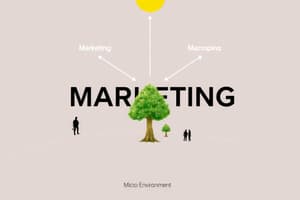Podcast
Questions and Answers
Which component of the microenvironment includes factors such as marketing departments and R&D?
Which component of the microenvironment includes factors such as marketing departments and R&D?
- Competitors
- The Company (correct)
- Suppliers
- Publics
What role do marketing intermediaries play in the microenvironment?
What role do marketing intermediaries play in the microenvironment?
- They create the products and services.
- They help in promoting, selling, and distributing products. (correct)
- They provide the financial resources for marketing.
- They analyze consumer behavior and preferences.
Which of the following is a factor in the macro-environment that affects consumer purchasing power?
Which of the following is a factor in the macro-environment that affects consumer purchasing power?
- Technological advancements
- Competitor behaviors
- Economic conditions (correct)
- Marketing strategies
In a marketing context, which of the following best describes 'publics'?
In a marketing context, which of the following best describes 'publics'?
Which macro-environment factor includes characteristics such as age and income levels?
Which macro-environment factor includes characteristics such as age and income levels?
What is an example of a company responding to the natural environment?
What is an example of a company responding to the natural environment?
Which factor influences how companies produce and deliver their products?
Which factor influences how companies produce and deliver their products?
What is a key characteristic of the competitors in a company's microenvironment?
What is a key characteristic of the competitors in a company's microenvironment?
What primarily influences how products are marketed in family-oriented cultures?
What primarily influences how products are marketed in family-oriented cultures?
Which factor is most likely to impact the advertising strategies of a tobacco company?
Which factor is most likely to impact the advertising strategies of a tobacco company?
How can societal values and norms affect consumer preferences?
How can societal values and norms affect consumer preferences?
What does the reaction of South Korean consumers to new technologies indicate about their cultural attitudes?
What does the reaction of South Korean consumers to new technologies indicate about their cultural attitudes?
In which scenario would a company be likely to emphasize technical product details in their marketing?
In which scenario would a company be likely to emphasize technical product details in their marketing?
What marketing strategy might a company use in Japan during gift-giving seasons?
What marketing strategy might a company use in Japan during gift-giving seasons?
What is a common challenge companies face when localizing their advertising across different languages?
What is a common challenge companies face when localizing their advertising across different languages?
Why might companies in predominantly Muslim countries avoid certain ingredients in their food products?
Why might companies in predominantly Muslim countries avoid certain ingredients in their food products?
What does company sales potential encompass?
What does company sales potential encompass?
Which of the following best defines market demand?
Which of the following best defines market demand?
How is company demand defined in relation to market demand?
How is company demand defined in relation to market demand?
What factor does NOT directly influence a company's sales potential?
What factor does NOT directly influence a company's sales potential?
Which method is NOT typically used for forecasting market demand?
Which method is NOT typically used for forecasting market demand?
What is the primary focus of behavioural research in marketing?
What is the primary focus of behavioural research in marketing?
Which of the following defines primary data?
Which of the following defines primary data?
What aspect is NOT typically addressed in the development of a research plan?
What aspect is NOT typically addressed in the development of a research plan?
Which research approach involves observing consumers in real-time as they shop?
Which research approach involves observing consumers in real-time as they shop?
What is laddering used for in market research?
What is laddering used for in market research?
What type of data are focus groups primarily based on?
What type of data are focus groups primarily based on?
In the buyer decision process, which stage comes first?
In the buyer decision process, which stage comes first?
Which of the following best describes secondary data?
Which of the following best describes secondary data?
What does market demand refer to?
What does market demand refer to?
Which of the following accurately describes company demand?
Which of the following accurately describes company demand?
How is a company's sales forecast typically determined?
How is a company's sales forecast typically determined?
What does market potential indicate?
What does market potential indicate?
Samples comprising less than 1% of a population are considered to provide what kind of reliability?
Samples comprising less than 1% of a population are considered to provide what kind of reliability?
Which of the following best describes neuromarketing?
Which of the following best describes neuromarketing?
In the smartphone example provided, what is considered as market demand?
In the smartphone example provided, what is considered as market demand?
Which component is NOT a part of the sampling plan?
Which component is NOT a part of the sampling plan?
Flashcards are hidden until you start studying
Study Notes
Marketing Environment
-
The marketing environment encompasses external factors affecting a company's relationship with its customers.
-
Divided into two categories: microenvironment (internal factors) and macroenvironment (external forces).
Microenvironment
-
The company's internal departments (e.g., marketing, finance, R&D) influence marketing strategy. Internal departments collaborate to develop products and strategies based on market demands.
-
Suppliers provide materials and services needed for production. Strong supplier relationships ensure quality and timely delivery.
-
Marketing intermediaries help promote, sell, and distribute products. Companies rely on intermediaries like retailers and e-commerce platforms to reach customers.
-
Competitors offer similar products or services. Understanding competitors' strengths and weaknesses informs strategic decisions.
-
Customers are the target audience for products and services. Understanding customer needs and preferences is crucial for effective marketing.
-
Publics are groups that impact or are impacted by marketing efforts. Public relations strategies focus on building positive relationships with publics such as communities and media.
Macro-environment
-
Demographic environment includes population characteristics like age, gender, education, and income. Companies tailor products and marketing to specific demographics.
-
Economic environment includes economic conditions like inflation, unemployment, and economic growth affecting consumer purchasing power. Companies adjust pricing and marketing to adapt to economic fluctuations.
-
Natural environment encompasses environmental factors like climate change, resource availability, and environmental regulations. Sustainable practices are increasingly important.
-
Technological environment includes changes in technology impacting production and delivery. Companies must adapt to technological advancements to stay competitive.
-
Political and Legal environment includes government regulations, policies, and legal factors. Companies operate within legal frameworks and regulations.
-
Socio-Cultural environment includes societal values, beliefs, and norms shaping consumer preferences. Companies understand cultural nuances to adapt marketing strategies.
Socio-Cultural Environment: Factors influencing consumer behavior
-
Cultural values and beliefs guide behavior within a society. Companies understand cultural values to tailor marketing messages.
-
Social norms and customs are accepted rules influencing behavior in specific settings. Companies consider social norms and adapt marketing to specific situations.
-
Lifestyles reflect how people live their lives, including interests and spending patterns. Companies target specific lifestyles with relevant products and marketing.
-
Language and communication styles affect marketing strategies. Companies localize marketing materials for different cultures and languages to avoid misunderstandings.
-
Education levels affect consumer preferences. Companies tailor their messages to reflect different levels of education.
-
Religious beliefs impact product design and marketing strategies. Companies cater to religious beliefs by offering appropriate products and marketing.
-
Attitudes toward change and innovation vary across societies. Companies adapt to different levels of innovation acceptance to market products effectively.
Marketing Research: Understanding Consumers
-
Systematic process of gathering, analyzing, and interpreting information about a market, product, or service.
-
Defining the problem is the first step in marketing research. Clearly identify the problem to be addressed.
-
Developing the research plan outlines the research approach, data sources, and how the information will be collected and analyzed.
-
Data sources can be primary (freshly collected) or secondary (already existing).
-
Research approaches include observational research, focus groups, surveys, and behavioral research.
-
Behavioral research aims to understand consumer behavior and attitudes, such as customer decision-making processes and satisfaction levels.
-
Research instruments are used to gather data. Examples include questionnaires, qualitative measures (word association, visualization), brand personification, and laddering.
-
Neuromarketing studies the effect of marketing stimuli on brain activity using devices like skin sensors, eye tracking, and brain wave scanners.
-
Sampling plan determines who to survey, the sample size, and the sampling procedure.
-
Data mining extracts valuable information from large datasets to identify trends and patterns.
-
Analyzing the information and making decisions involves interpreting the collected data and drawing conclusions.
Market Demand, Company Demand, and Market Forecasting:
-
Market demand is the total quantity of a product or service consumers are willing and able to purchase at a given price.
-
Company demand is the portion of market demand that a specific company can capture.
-
Company sales forecast is an estimated sales volume for a specific period, based on factors like historical data, market trends, and marketing strategies.
-
Market potential represents the maximum possible sales volume if all potential customers purchased the product.
-
Company sales potential is the maximum possible sales a company can achieve within the market potential.
-
Forecasting market demand requires methods like industry sales analysis, surveys of buyer intentions, composite of sales force opinions, expert opinions, past sales analysis, and market tests.
Studying That Suits You
Use AI to generate personalized quizzes and flashcards to suit your learning preferences.




